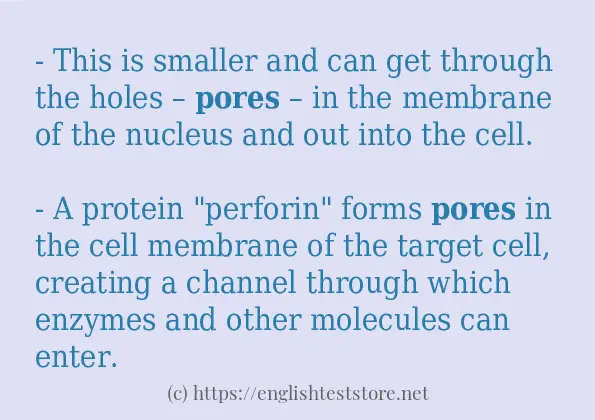How to use in-sentence of “pores”:
– This is smaller and can get through the holes – pores – in the membrane of the nucleus and out into the cell.
– A protein “perforin” forms pores in the cell membrane of the target cell, creating a channel through which enzymes and other molecules can enter.
– Transfection of animal cells usually involves opening temporary pores in the cell membrane, to allow the cells to take up the vector.
– Applying hot water will open up the pores and reduce the damage because it will require less force to pop it.
– The best way to tell the two apart is the pores under the jaw.
– Sebum and dead skin cells can mix with a type of Microorganismgerm called pores in the skin.
– Their bodies are full of pores and channels allowing water to circulate through them.

Example sentences of “pores”:
– The stationary phase can be membranes, special beads, or supports with different-sized pores in them.
– Water circulating through pores allows for gas exchange as well as food filtration.
– The epidermis is covered with pores called “stomata”.
– Water from the ground, lakes, or oceans seeps into the pores of organic tissue and forms a crystal cast with deposited minerals.
– They have a thicker body wall and elongated pores that form a simple canal system.
– Structurally, the sponge body is studded with numerous pores called ostia that lead to canals for channeling water to internal chambers.
– Because the sandstones are permeabilitypermeable, water gradually makes its way through the pores between the sand grains, flowing at a rate of one to five metres per year.
– Rotaviruses avoid this by not uncoating fully inside the cell and by releasing newly produced mRNA through pores in the particle’s inner capsid.
- The stationary phase can be membranes, special beads, or supports with different-sized pores in them.
- Water circulating through pores allows for gas exchange as well as food filtration.
– All sponges take in water through pores in their bodies.
– The scars, or leaf cushions, were composed of green Photosynthesisphotosynthetic tissue, evidenced by the cuticle covering and being dotted with stomata, microscopic pores through which carbon dioxide from the air diffuses into plants.
– The pores of the earthenware are now full of water.
– Movement of large molecules such as proteins and RNA through the pores is required for both gene expression and the maintenance of chromosomes.
– A pair of gonads are in the mid-region of the trunk, and open to pores in the final segment.
